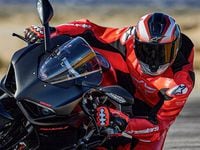Usually, my interest in such things is purely technological, and I’ll get to that. But there is potentially something here more important than technology. Formula One cars are overtly high-tech, covered with aero devices that fascinate the onlooker. They look fantastic.
Grand Prix motorcycles look like every other sportbike in the world. Were it not for their splashy graphics, MotoGP grids would look just like rows of production R1s with their lighting removed.
That could all change if the FIM and DORNA could find ways to legalize safe aerodynamic devices. MotoGP bikes with wings and strakes could add visual drama to the sport and send strong waves into the aftermarket.
Wings on racing cars have the primary purpose of pressing the car more forcefully down against the track, thereby increasing tire grip and corner speeds. A secondary purpose is to prevent four-wheeled aviation of the kind that has on occasion sent racing cars flipping through the air. The claim, heard for many years, is that F1 downforce is so effective that the cars could race upside-down on a ceiling.
Long ago, back in the days when every F1 car was growing wing arrays, Colin Lyster, ever the trend-seeker, showed a race bike with a strut-mounted wing. It was clear that for every pound of downforce that wing generated when the bike was upright, it would generate at least half a pound of sideforce tending to push the bike off the track on fast turns.
If this is what wings-on-bikes do, what are Ducati and the others trying to accomplish?
The bike winglets of today are mounted up front, rather like “moustaches” on the front of the fairing. Their clear purpose is to provide a force that opposes front wheel lift and the loss of control it causes. Remember that in 2004, Valentino Rossi said, “The wheelie is the enemy.” As riders accelerate with the machine upright, engine power can lift the front wheel up at well over 100 mph. To keep the front wheel from continuing to lift and the bikes blowing over backward, the rider must use less than full throttle up to this speed. What a waste! Watching the bikes accelerate away from Indianapolis’s Turn 1-2 complex, it was possible to see the anti-wheelie systems of the major teams at work–and they all work by limiting throttle to keep the front tire just hovering near the pavement, never threatening to lift up and flip.
This is one job for front downforce–to keep the front tire from lifting and destroying control. This compels either the rider or the anti-wheelie system to cut power.
Now consider corner exit. The rider throttles up as much as rear grip and front lift allow. And what if rear grip allows the front to lift? The front tire stops steering the bike, which runs wide. Riders pull themselves forward on the bike to prevent this, but it’s not enough. Even a modest downforce in this situation could usefully increase the amount of throttle the rider can use.
Naturally, Race Direction, DORNA, the FIM, and the riders never want to see the headline, “Killer winglet gores rider.” Such devices must be safely designed.
Note, two paragraphs above, the words “a modest downforce.” Look at the devices currently being tested; Yamaha and Ducati have shown stubby “moustache” winglets, located in the accelerated airflow moving around the fairing nose, and Honda’s look like the turned-up points of an Edwardian gentleman’s wing collar. All we have seen so far would be strong enough even if molded of rubber.
How much force? Aircraft wing loadings give a clue, being in the range of 25 to 70 pounds per square foot in a range of 140 to 200 mph, and lift varies as the square of speed. Efficient wings are shaped like a foot ruler, with a lot of length in relation to the inefficient tips. At the wingtip, air from the high pressure side can flow around to the low-pressure side, negating some lift. Some of the winglets we’ve seen have tip fences to limit this spillage, but even so, let’s estimate the force-generating potential of these winglets as 25 pounds per square foot at 120 mph. Honda’s two “wing collar” winglets perhaps total 10 square inches, or about .07 square foot. That suggests maybe two pounds of downforce. If Ducati’s have seven times that area, we could estimate 14 pounds of downforce at 120 mph, 3 to 4 pounds at 60 mph, and at top speed (217 mph on some circuits) 45 pounds.
Those are small amounts, but as noted above, there are definitely situations in which even a very few pounds of “negative skyhook” force could be useful.
Remember, a road racing motorcycle is basically a dragster with some limited turning ability. To make race bikes maneuver quickly they need wheelbases in the range of 55 to 56 inches. To give them clearance to lean over as far as modern tires permit, their major masses must be mounted fairly high. Real dragsters, by contrast, have very long chassis and their engine sumps are barely clear of the ground. This means that every time you try to accelerate on a MotoGP bike, the front end is trying to come up, eroding rider control.
We know that the trend in motor sports business management is to regard anything that helps a team to win races as “de-stabilizing technology creep.” Aero downforce devices definitely fall into this category. But because aero devices have terrific eye-grabbing power and could make MotoGP bikes as visually different from streetbikes as F1 cars are from grocery-getters, I think they must be considered.
Aero people would probably like to mount a narrow, efficient wing as long as the bike is wide (19 inches) in front of the fairing and above the front tire. Could this be done safely? That’s up to engineering; good design manages other potential hazards such as toothed sprockets, hot exhaust systems, and handlebar ends.
Our 19 in. front wing could easily be pivoted, its angle of attack controlled by a stepping motor and some basic computer instructions, exactly as throttle-by-wire is now controlled on streetbikes. With an area of half a square foot, it would efficiently generate useful downforce. Why control its angle of attack? When you create lift, you also create drag, so an ideal wing would provide just the downforce needed and no more.
There’s the argument; aero devices could add to MotoGP some of the tech fascination previously reserved only to Formula One.












/cloudfront-us-east-1.images.arcpublishing.com/octane/RMCT2KVQBJHBZMRTSLOVPMOILU.jpg)

/cloudfront-us-east-1.images.arcpublishing.com/octane/K45KB2XHQVA65DX7VN4ZSMT2BI.jpg)
/cloudfront-us-east-1.images.arcpublishing.com/octane/BIVAK2SFIBDJJM25E7I5VU2FJE.jpg)
/cloudfront-us-east-1.images.arcpublishing.com/octane/FNHXQQ56BRD7TO4YIJ453PNG2M.jpg)
/cloudfront-us-east-1.images.arcpublishing.com/octane/OIKJC4JA3ZH7BMKUGWYKBIY5FA.jpg)
/cloudfront-us-east-1.images.arcpublishing.com/octane/MT2SAEWY6FDXFBYSLDE3AEFDTM.jpg)
/cloudfront-us-east-1.images.arcpublishing.com/octane/66UPKPYVURBPRCP5HXSN56MEMM.jpg)
/cloudfront-us-east-1.images.arcpublishing.com/octane/EOREGDSRKFDCRJC6K3EDVHBGCE.jpg)
/cloudfront-us-east-1.images.arcpublishing.com/octane/42RF63Q3LVCMBP3DGTWXFYSMOA.jpg)
/cloudfront-us-east-1.images.arcpublishing.com/octane/XNVY3EVWZFCEVPUGJGAN633LXE.jpg)
/cloudfront-us-east-1.images.arcpublishing.com/octane/2PLTVHXY7FDSPFHKU5CFOC43ZY.jpg)
/cloudfront-us-east-1.images.arcpublishing.com/octane/B6M3WTRLFZGNXBEATNXPVGBBD4.jpg)
/cloudfront-us-east-1.images.arcpublishing.com/octane/4CMH3FI73BEM5D6MFYX42FLDSQ.jpg)
/cloudfront-us-east-1.images.arcpublishing.com/octane/RIHAPYNWU5H3XAOXNOPRWCBTQA.jpg)
/cloudfront-us-east-1.images.arcpublishing.com/octane/HU4NUBCL3VAFZA75VYRCMAUHVM.jpg)
/cloudfront-us-east-1.images.arcpublishing.com/octane/OB43AZK7TRA6XLZL5WRDVW2TDA.jpg)
/cloudfront-us-east-1.images.arcpublishing.com/octane/5G44Y3FXWNFSTEQKCA355PXOPU.jpg)

/cloudfront-us-east-1.images.arcpublishing.com/octane/XRI4GTLCVBA5NESASCBIR5LYQI.jpg)
/cloudfront-us-east-1.images.arcpublishing.com/octane/EF7566PXARGMBAOMLWTECYL3LE.jpg)


